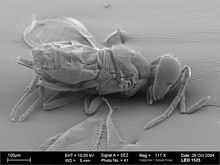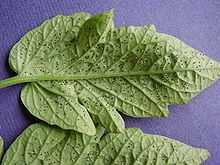Encarsia formosa
| Encarsia formosa | |
|---|---|
 | |
| Encarsia formosa | |
| Scientific classification | |
| Kingdom: | Animalia |
| Phylum: | Arthropoda |
| Class: | Insecta |
| Order: | Hymenoptera |
| Suborder: | Apocrita |
| Superfamily: | Chalcidoidea |
| Family: | Aphelinidae |
| Genus: | Encarsia |
| Species: | E. formosa |
| Binomial name | |
| Encarsia formosa Gahan, 1924 | |
Encarsia formosa is a species of wasp and a well known parasitoid of greenhouse whitefly. The tiny females (about 0.6 mm long) are black with a yellow abdomen and opalescent wings. There are considerably fewer males than females. They are slightly larger and are completely black in coloration.
Life cycle


Females deposit 50-100 eggs individually inside the bodies of third instar nymphs or pupae of the host species. The wasp larvae develop through four instars in about two weeks at optimum temperatures. Parasitized greenhouse whitefly pupae turn black in about 10 days, while parasitized sweet potato whiteflies turn amber brown. Both are easily distinguished from unparasitized host pupae. Wasp pupation occurs within the whitefly body. Adult wasps emerge about 10 days later.
Use in biological control
Encarsia has been used as a natural pesticide to control whitefly populations in greenhouses since the 1920s. Use of the insect fell out of fashion due to the increased prevalence of chemical pesticides and was essentially non-existent by the 1940s. Since the 1970s Encarsia has seen something of a revival, with renewed usage in European and Russian greenhouses.[1] In some countries, such as New Zealand, it is the primary biological control agent used to control greenhouse whiteflies, particularly on crops such as tomato, which is a particularly difficult plant for predators to establish on.[2]
Flight
E. formosa makes use of an unusual form of hovering flight. Unlike normal flight, this method would work in an entirely inviscid medium, as it does not rely on a starting vortex to create circulation about the wing. Instead, the wingtips briefly touch at the apex of their stroke, altering the topology of the surrounding medium.[3][4]
References
- ↑ MS Hoddle et al. (1998) Annual Review of Entomology Vol. 43: 645-669
- ↑ (http://www.bioforce.net.nz/products/enforce.html) Bioforce Limited, New Zealand
- ↑ T. Weis-Fogh, Quick estimates of flight fitness in hovering animals, including novel mechanisms for lift production, J. Expl. Biol. 59, 169-230, 1973
- ↑ M. J. Lighthill, On the Weis-Fogh mechanism of lift generation, J. Fluid Mech. 6 0, 1-17, 1973